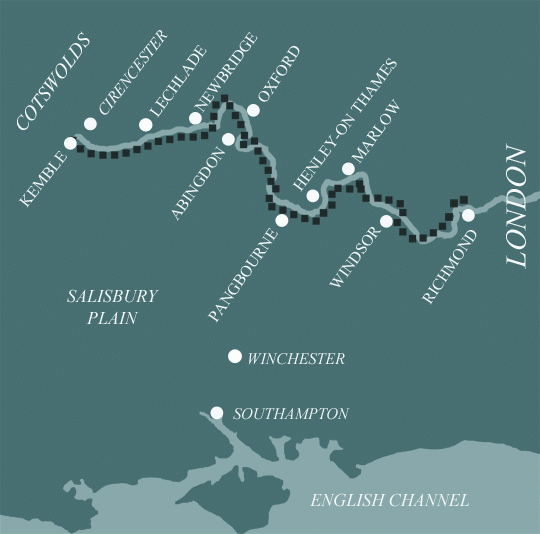Thames Path
Kemble to Thames Barrier in 20 Days Walking Code: TP21
We offer 3 itineraries covering the full Thames Path, from its rural source in the Cotswolds to the Thames Barrier in London. The route leads through peaceful countryside, charming villages, and historic towns, passing iconic landmarks along the way. Choose the itinerary that allows you time to explore this ever-changing landscape.
This 20 day alternative is a great walk for those who wish to take their time and visit the many historical villages and towns along the way. With an average daily distance of just over 9 miles you can savour the walk and enjoy the countryside and towns along the way. Beware there are a few days over 10 miles but the route is flat and straightforward.
| Miles | Km | ||
|---|---|---|---|
| Day 1 | Travel to Kemble for your first nights accommodation | ||
| Day 2 | Kemble to Ashton Keynes then transfer to Cricklade | 7 | 11 |
| Day 3 | Transfer back to Ashton Keynes then walk to Cricklade | 5 | 8 |
| Day 4 | Cricklade to Lechlade | 11 | 18 |
| Day 5 | Lechlade to Tadpole Bridge | 10 | 16 |
| Day 6 | Tadpole Bridge to Newbridge | 8 | 13 |
| Day 7 | Newbridge to Oxford | 14 | 23 |
| Day 8 | Oxford to Abingdon | 10 | 16 |
| Day 9 | Abingdon to Shillingford then transfer to Warborough | 10 | 16 |
| Day 10 | Transfer back to Shillingford then walk to Goring | 10 | 16 |
| Day 11 | Goring to Reading | 11 | 18 |
| Day 12 | Reading to Henley-on-Thames | 9 | 14 |
| Day 13 | Henley-on-Thames to Marlow | 9 | 14 |
| Day 14 | Marlow to Maidenhead | 8 | 13 |
| Day 15 | Maidenhead to Eton / Windsor | 7 | 11 |
| Day 16 | Eton / Windsor to Staines-Upon-Thames | 9 | 14 |
| Day 17 | Staines-Upon-Thames to East Molesey | 12 | 19 |
| Day 18 | East Molesey to Richmond upon Thames | 8 | 13 |
| Day 19 | Richmond upon Thames to Wandsworth | 9 | 14 |
| Day 20 | Wandsworth to Covent Garden | 7 | 11 |
| Day 21 | Covent Garden to Thames Barrier then bus transfer to Blackheath | 11 | 18 |
| Day 22 | Depart from Blackheath after breakfast |
Kemble to Cricklade
During summer the start of the route often follows a dry river bed but it isn’t long until the river in its infancy appears. This section is particularly beautiful during spring when the fields are full of wild flowers. The Thames passes beautiful Cotswold villages renowned for their golden coloured stone which has been quarried from the areas Jurassic limestone bedrock. Just after passing through the hamlet of Ewen you are surrounded by the Cotswold Water Park on your route to Cricklade. Over the last 50 years this area set over 40 square miles has transformed from gravel pits to 150 lakes. Providing water sports and recreational activities along with many wildlife nature reserves. Keep your eyes out for all sorts of movement from water voles, shrews, and otters to dragon flies, chiffchaff’s and water rail.
Cricklade to Lechlade
Follow the small reed filled river to Castle Eaton where a lychgate leads to a 12th Century church with Norman and early English gothic style along with a very distinctive corbelled bellcote which was added by William Butterfield in 1861-63. Continue along the river to Upper Inglesham. You might be interested to visit the simple but magnificent church at Inglesham which has managed to avoid the Gothic restoration treatment of the Victorian age before trying to spot some of the first boats on the Thames as you approach the 18th century bridge into Lechlade called the Ha’penny bridge due to the toll once charged.
Lechlade to Newbridge
Leaving Lechlade you pass St John’s lock the furthest upstream lock on the Thames and the highest point on the Thames that trading barges are able to reach. This is just the first of 46 locks along the Thames path. You’ll be greeted here by the statue ‘Old Father Thames’ which was crafted by Raffaelle Monti in 1851 and has been relocated twice before being re-homed in Lechlade in 1974. Continue on past decaying pillboxes (concrete dug-in guard post) once used as a defence line in 1940 and now home to bats. The path meanders through the flat flood plain of the Thames valley passing another 5 locks, Chimney Meadow nature reserve and wonderfully named bridges, such as Tadpole Bridge, Newbridge (actually 13th century), the Tenfoot bridge (which is wider than 10 feet), along with the oldest bridge which is located in Radcot and made up of three gothic arches made of Taynton stone. You may be interested to stop and see Kelmscott, the home of William Morris (check the opening times).
Newbridge to Oxford
The river continues to grow on your journey towards Oxford, it is now already a respectable size with many boats negotiating its locks. Although today you will be heading towards a city, this part of the path is very rural, almost until reaching the city’s edge. As you wind your way along the path today you pass through Bablock Hythe, maybe the best known of the Thames crossings. A chain hauled ferry operated here for over 1000 years but now lies in disrepair after floods in 2007. A campaign is currently up and running to see it returned to its former glory. Pass Swinford Bridge, built in 1770 for the Earl of Abingdon and one of two remaining privately-owned toll bridges on the Thames, before passing the edge of Wytham Great Wood, a 600 acre wood and wildlife haven. Finally finishing through Port Meadow with stunning skyline views of Oxford and its spires, you’ll understand why Matthew Arnold coined Oxford as the ‘city of dreaming spires’. This area is largely unchanged since William the Conqueror gifted the land in return for helping to defend his kingdom from the Danes.
Oxford to Abingdon
The path skirts the edge of the city, the route is surprisingly green and after passing Iffley lock and the charming Norman Iffley church it continues through its rural setting. Walking through open meadows you pass through Sandford-on-Thames, mentioned in the Doomsday book of 1086 for its milling. Sandford Lock is also known for having the largest fall of 2.69 metres and a weir pool named the Sandford Lasher renowned for its strong undercurrents and taking many lives over the years. An Obelisk marks the spot as a reminder. Continue on past Nuneham House which after Lord Harcourt had it built for him in 1756, also had the original village of Nuneham knocked down and the road from Oxford to London re-routed in order to have the grounds landscaped. Much of this landscaping didn’t survive the second world war. Before reaching Abingdon, you pass an entrance to the Swift Ditch of the back water, originally the faster route on the Thames, and thought to be dug by monks of Abingdon abbey. Abingdon claims to be the oldest continuously occupied settlement in the country with Palaeolithic, Mesolithic, Neolithic and bronze age remains found. Along with evidence of an Iron age and Middle Iron age oppidum (fortified town). Abingdon Abbey was built in the seventh century and gave the town its present name.
Abingdon to Wallingford
This section starts and ends in historical towns. Wallingford is home to the remains of a medieval castle. It was demolished in 1652 on the orders of Oliver Cromwell. It is described by Nicholas Brooks as once being “one of the most powerful royal castles of the 12th & 13th century”. Built on the orders of William the Conqueror. Pass the ancient hamlet of Culham which is virtually surrounded by open fields and after reaching Clifton lock enjoy the picture-perfect scene of the red bricked Clifton Hampden Bridge and the church spire ascending out from behind. Continue on following the sweeping arch of the Thames to Little Wittenham the home for the World Pooh sticks competition and Wittenham clumps also known as the Sinodun Hills which offer magnificent views if you have the energy to climb either of them. A short diversion to Dorchester will allow you to see the impressive ancient Abbey in Dorchester built around 1140 before passing a delightful thatched boathouse at Shillingford and the impressive Benson weir, before reaching Wallingford.
Wallingford to Pangbourne
A contrasting and attractive section starts in the historic town of Wallingford and passes though Goring Gap, a dramatic valley carved through chalk hills by the river during the ice age. Its original route saw the Thames meeting the North Sea near Ipswich but after its paths were blocked by sheet ice it carved its way through the chalk site and took the new route we know today. Today’s section also has one of the few short climbs up the chalk hills and a steep ascent to negotiate at Coombe Park before you reach Pangbourne.
Pangbourne to Henley
Skirting the edge of Reading is quieter than you might think and is broken by Kings Meadow park and the place where the Kennet canal enters the Thames (a project which linked Reading with Bath and Bristol in 1810). On leaving Reading enjoy the 11 different sized archways of Sonning bridge which links the counties Oxon and Berkshire. Pass a beautiful boathouse at Shiplake and probably some boaters out training for an annual Regatta held here, second in size only to Henley. Continue on enjoying the beautiful properties on the Thames edge and the striking Park Place, an imposing country house and some of its prominent features such as the Conway bridge made of massive irregular blocks. This estate at one point being sold for £140 million and makes it Britain’s most expensive house. You enter Henley to rows of moored boats and an array of boating activities taking place. Henley is world-famous for its remarkably straight regatta course, with the first Oxford vs Cambridge race rowed in 1829.
Henley to Marlow
As you leave Henley don’t miss out on taking in the much-photographed bridge and tower of St Mary’s and following the regatta mile route down to its start, marked by a delightfully quaint temple on Temple Island. Follow the river on a shape bend, past a series of weirs at Hambleden Mill and across open fields, and past impressive buildings such as Frogmill Barn and Danesfield castellated mansion to Hurley. Enjoy Hurley lock with its many channels. An area used frequently by kayakers for its four main weir gates and the size and shape of waves created. Carry on to cross the wooden Temple footbridge, put in place to replace the ferry that closed in 1953, and through open meadowland to Marlow. Cross the splendid suspension bridge and enjoy the juxtaposition of the bridge against All Saints pinnacles (a medieval church) which has been well photographed over the years. Marlow is also the home to St Peter’s Church which is said to home the mummified hand of the Apostle St James who was present at the last supper.
Marlow to Windsor
A beautiful stretch of the river today with open land, wooded slopes on the opposite banks and grand homes. On leaving Marlow you pass a small section with no tow path, where towing horses use to have to be led along a very difficult route along seven corner alleys. Continue on past a mini-castle with turrets and battlements, Bourne End; an area popular for dinghy sailing to Cookham. As you walk through Cookham look out for a large sarsen block called the Tarry stone and is said to be an original meeting place for the local ‘Olympics’, the centre of the home territory of the terrifying ghost Herne the Hunter, said to hold special powers which allegedly cursed a local family after they moved the stone. Pass a slight diversion as the river splits into 4 channels and further along the beach tree covered hill of the Cliveden Estate on the opposite side of the river and the hustle and bustle of Boulter’s Lock and Maidenhead. Before reaching Windsor the path passes Dorney lake which is part of Eton college and the home to rowing, flat water and slalom canoeing and kayaking in the 2012 Olympics before continuing on to see Windsor castle towering over the town.
Windsor to Shepperton
This section is varied and passes through Runnymede, an area with a wealth of historic and symbolic significance which highlights the importance played by the Thames. Although the river is now getting closer to London you still get to enjoy a considerable amount of green space before you hit Shepperton. As you leave Windsor enjoy the distant back drop of Windsor Castle as you cross parklands past Datchet to Runnymede. Somewhere, here in Runnymede meadow is where King John in 1215 set his seal on the Magna Carter which still forms an important symbol of liberty today. In remembrance a memorial was built in 1957 at the foot of Cooper’s Hill. There are also two additional memorials here; The Air Force Memorial unveiled in 1953 by the Queen for the 20,456 airmen who lost their lives in World War II and have no known grave. The other for John F Kennedy was unveiled in 1965. On the opposite bank is the Ankerwycke ancient yew close to the ruins of St Mary’s priory is said to have both witnessed the signing of the Magna Carta and been where Henry VIII & Anne Boleyn met in the 1530’s. The path passes Penton Hook island, a wildlife haven and perhaps the most impressive loop on the Thames which can be explored by crossing the lock gates and main weir. Enjoy some of the last open meadowlands before you get to Chertsey Meads.
Chertsey to Richmond upon Thames
The last country walking section of the non-tidal part of the Thames path is rife with reservoirs. It is the last non-tidal stretch of the Path as beyond Teddington Lock the River Thames is tidal. The walk to Richmond has two options, the north or the south bank. Most people choose the south bank as the north bank is longer by three miles and not as pleasant and green as the south bank. The walk along the south bank heads for Teddington Lock and continues on to Ham Lands Nature Reserve and Petersham Meadows. You will see an enormous building on top of Richmond Hill called the Star and Garter Homes, this was constructed during the first world war to house injured soldiers. It is worth a walk up to Richmond Hill for its fine views over the river Thames as immortalised by JMW Turner.
Richmond upon Thames to Thames Barrier
The path follows the edge of the Kew Royal Botanical Gardens to Kew Bridge before snaking its way past Mortlake and Hammersmith Bridge. The boathouses of the many rowing clubs greet you as you approach Putney with its famous Bridge. Putney Bridge boasts at church at either end, with All Saints on the north side and St Mary’s on the south. The gentle walk through Battersea Park is pleasant ahead of the buzz of London’s Southbank, home to the National Theatre and the Tate Modern among many other tourist attractions. There are fabulous views across the river to Westminster and the Tower of London. HMS Belfast, now permanently moored as a museum ship, and operated by the Imperial War Museum sits between London Bridge and Tower Bridge. Leaving Tower Bridge and the tourists behind the path winds its way through the Docklands and onto Greenwich. The official end of the path is beyond Greenwich at the Thames Barrier. Spanning 520 metres it is protector to 125 square kilometres of central London from potential flooding caused by tidal surges. Perhaps more immediately important to you the walker, it marks the end of your Thames Path Journey.
Easy to Moderate
Of the National trails we cover, this is one of the easiest. It is a gentle trail which is suitable for people with a wide range of abilities. The route journeys across obvious broad promenades to grassy paths.
Terrain: Mostly flat with well defined paths.
What’s it like underfoot? You may be walking on an obvious trail, path or pavement and occasionally on a path across a field just visible in the grass. The terrain when dry is often compact and easy going, however, when wet it can be muddy in sections.
How much up and down? If you start at the source the route spends the majority of the walk losing height. After you pass through Goring Gap there is a short climb up the chalk hills and steep descent to negotiate at Coombe Park before you reach Pangbourne.
Signposting: Good signposting, signs are marked with a white acorn to indicate the National Trail.
Navigation: Pretty straightforward, keep your map and guidebook to hand.
|
All Holidays
|
|
| Accommodation | Overnight Bed and Breakfast accommodation in selected hotels, farmhouses, village inns, guest houses and family B&Bs. Full English or Continental breakfast. |
| Guidebook | A detailed guidebook with route information, maps, photos and background information. |
| Information of Services Along the Route | A comprehensive Service Info sheet, including services such as cash points, banks, post offices, village shops, inns, cafes and taxis. |
| Maps | A waterproof (1:40,000) Harvey Map covering the whole route. |
| Personal Itinerary | A personal itinerary setting out each overnight stop, including large scale maps of each accommodation, to ensure you find it easily. |
| Emergency Telephone Support | If you get in to difficulties during your holiday, we are always available to help, even out of office hours. |
|
Options
|
|
| Luggage Transport | We will transfer your luggage between each overnight stop – if you leave your luggage at the accommodation when you set off in the morning, it will be moved on to your next B&B. You only need to carry a small day sack with the clothes and provisions you require during the day’s walk. |
| Packed Lunches |
We are unable to pre book packed lunches on this route. However, some accommodations will be happy to prepare a packed lunch if requested on arrival. |
| Off Road Parking | If you are travelling by car we can usually arrange off road parking for the duration of your trip. (There may be a small charge for this). |
| Arrangement of return transport | We can also arrange your transfer back to your car, (or advise you when public transport is a better option)! |
|
What’s not Included
|
|
| Evening Meals | Your evening meal isn’t included in the package, but we include full details and recommendations for each evening meal in your itinerary. You will normally be within walking distance of a pub and/or restaurant, or where there is good food available at the accommodation, we’ll book that for you. Allow about £30.00 per night. |
| Transport to the Start & Away from the Finish | Have a look at the ‘Travel Info’ tab above for suggestions. If you’re still struggling, get in touch and we’ll help you sort it out. |
| Travel Insurance | Even if you are based in the UK travel insurance is worth having. |
Good accommodation and friendly hosts are an essential part of any holiday. We understand this and go out of our way to find the best. We put a great deal of effort into hand picking our accommodation and matching it to individual customer requirements. As well as visiting the accommodation ourselves, we ask all our customers to complete a short evaluation on each night’s accommodation, which then gives us an insight into the day-to-day operation and lets us spot any potential issues before they become a problem.
We use a variety of accommodation. Over the course of your trip you might stay in a village inn, a bed and breakfast in a converted barn, a Victorian guest house, or on a working farm. In selecting the accommodation we look for helpful, friendly hosts with good quality, characterful accommodation close to the trail. Occasionally we may use a chain hotel.
We always try to arrange en suite accommodation, i.e. rooms with their own bathrooms for each night of your stay. However, in some of the more remote locations accommodation is limited and occasionally we may have to book rooms with shared bathrooms for one or two nights of your holiday, (especially if the booking is made at short notice), but we will always let you know if this is likely to be the case.
We are happy to book single rooms on our holidays but cannot normally book more than two for any one group. Single room bookings include a supplement.
Here are some examples of the accommodation we use on the Thames Path:
 The Trout Inn at Tadpole Bridge is a beautifully refurbished boutique inn nestled in the West Oxfordshire countryside. The large beer garden is perfect for sunny days, while the cosy bar and boutique bedrooms offer year-round comfort. Guests can enjoy seasonal dishes, pub classics, and award-winning Butcombe beer. Visit their website
The Trout Inn at Tadpole Bridge is a beautifully refurbished boutique inn nestled in the West Oxfordshire countryside. The large beer garden is perfect for sunny days, while the cosy bar and boutique bedrooms offer year-round comfort. Guests can enjoy seasonal dishes, pub classics, and award-winning Butcombe beer. Visit their website
 The Great House at Sonning is a former Elizabethan coaching inn. This charming riverside escape features stylish rooms, a glass-covered terrace, and a lawned garden leading to the water. Nestled on a peaceful stretch of the river in the picturesque village of Sonning-on-Thames, this is a perfect place to unwind and explore. Visit their website
The Great House at Sonning is a former Elizabethan coaching inn. This charming riverside escape features stylish rooms, a glass-covered terrace, and a lawned garden leading to the water. Nestled on a peaceful stretch of the river in the picturesque village of Sonning-on-Thames, this is a perfect place to unwind and explore. Visit their website
 The Chequers is a charming venue in the heart of Marlow offering cosy, stylish rooms that will have you longing to return time and time again. Known for hearty British cuisine, it serves fresh, seasonal dishes crafted from local ingredients, including signature sharing steaks cooked to perfection, alongside a variety of tempting options. Visit their website
The Chequers is a charming venue in the heart of Marlow offering cosy, stylish rooms that will have you longing to return time and time again. Known for hearty British cuisine, it serves fresh, seasonal dishes crafted from local ingredients, including signature sharing steaks cooked to perfection, alongside a variety of tempting options. Visit their website
 The Hand and Spear in Weybridge is a stylish pub with rooms, offering hearty pub classics and a welcoming atmosphere. Its 12 charming bedrooms are individually decorated, blending comfort and character. Conveniently located near Weybridge station, it’s just 30 minutes from Central London and close to both Heathrow and Gatwick airports. Visit their website
The Hand and Spear in Weybridge is a stylish pub with rooms, offering hearty pub classics and a welcoming atmosphere. Its 12 charming bedrooms are individually decorated, blending comfort and character. Conveniently located near Weybridge station, it’s just 30 minutes from Central London and close to both Heathrow and Gatwick airports. Visit their website
General travel information for the Thames Path walk will be in your holiday pack.
Detailed instructions on getting to your first night’s accommodation by car, or on foot from the nearest train or bus station, will also be included in the holiday pack on individual accommodation maps.
To view train times please visit trainline where you can also purchase tickets in advance. For information on bus timetables please visit traveline
If you require secure car parking whilst walking this route, please contact us for information.
Getting to Kemble:
By Air: The nearest airports are Heathrow and Bristol. From Heathrow: either bus to Reading, then train to Kemble (change at Swindon) or Heathrow Express to Paddington, then train to Kemble.
From Bristol airport: Bus to Bristol Temple Meads, train to Kemble (change at Swindon).
By Public Transport: There is a railway station at Kemble. There are direct trains from London Paddington to Kemble.
By Road: From the north take the M5 to exit 11A then A417 to Kemble. From London M4 to exit 15, then A419.
Returning from Blackheath:
By Public Transport: Blackheath Railway Station is located on the North Kent and Bexleyheath Branch Lines, both of which are off the South Eastern Main Line at Lewisham for connections to London Victoria and London Bridge/Cannon Street.
By Road: Blackheath is located in Central London on the B212, just off the A2 approaching Greenwich.
Oxford
The ancient university town of Oxford is well worth an extra day. There are many different walking tours of the town which can be booked in advance. You can also visit the Ashmolean Museum and the Museum of Natural History as well as many others. And why not hire a punt and see the river Thames from a whole new perspective!
Eton / Windsor
There is plenty to see and do on a rest day in Windsor. There is of course Windsor Castle, you may be lucky and be there on a day when the changing of the guard takes place, you can find out more via: Changing of the guard
It is easy to while away the day in the beautiful gardens Cliveden and the Savill Garden. You could finish off the day with a visit to Dorney Court, a 15th century Tudor Manor House and gardens.
Richmond upon Thames
We would recommend a rest day in Richmond to allow you the time to visit the spectacular Kew Gardens. You can easily while away a day in these famous botanic gardens. Visit the largest Victorian glasshouse in the world and wander around the extensive grounds with its multitude of exotic trees and plants. The largest Royal park in London, Richmond Park, is also close by with free roaming deer and extensive woodlands. For the hustle and bustle of the city you are only a short tube ride away from central London with its many museums, galleries and attractions.
| Prices | GBP (£) |
|---|---|
| Accommodation, map & guidebook only | £3333 |
| with Luggage Transport | £3893 |
Other Options |
|
| Extra Nights (per night) | £95 |
| Single Supplement (per night) | £68 |
| Solo Luggage Supplement (per day) | £28 |
